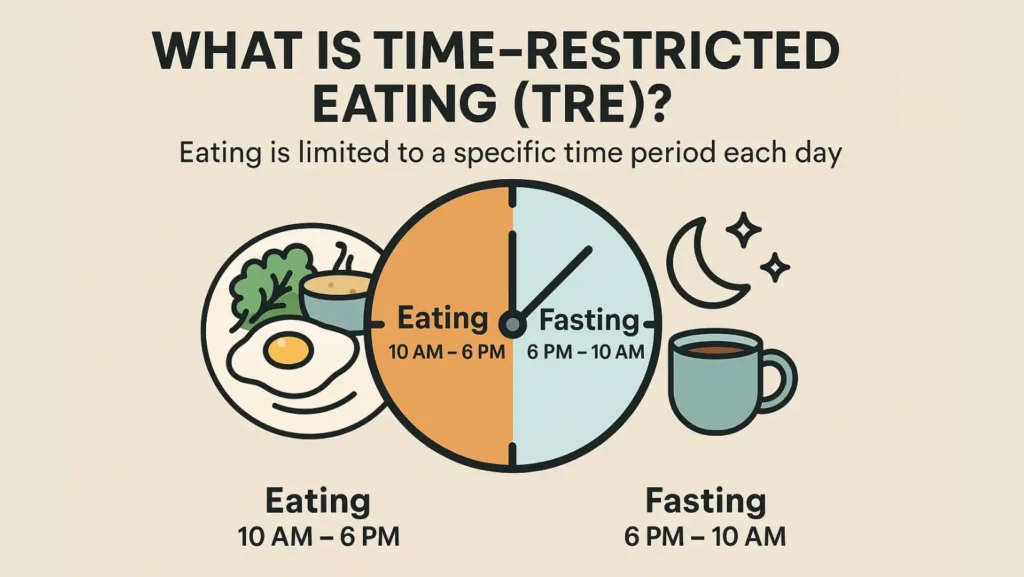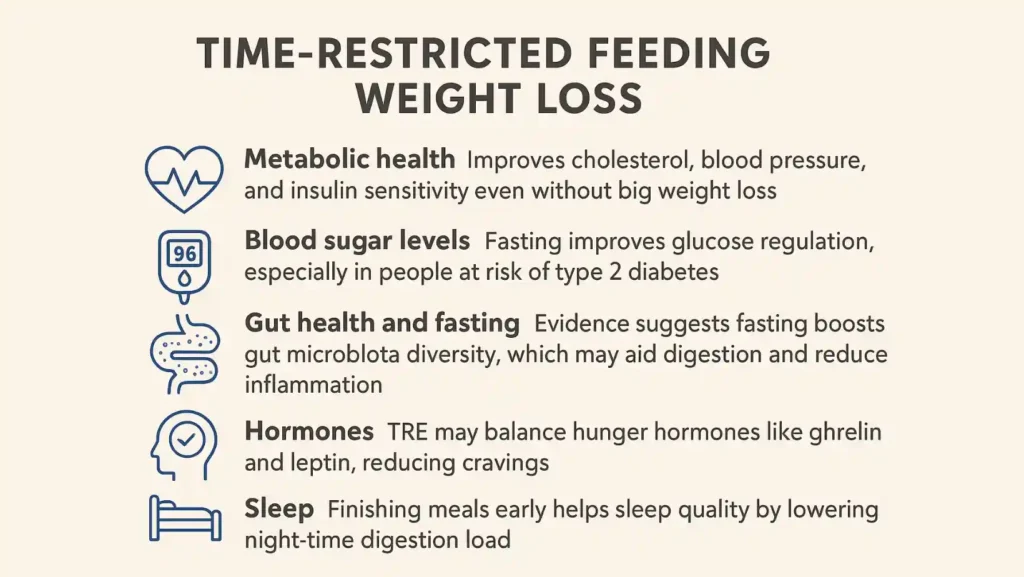Time-restricted eating has become a hot topic in health and fitness. Many people wonder if changing when you eat is just a trend or a science-backed way to improve health and support fat loss. The truth is, TRE is not only about skipping meals; it ties directly to how your body clock works, how your metabolism responds to food, and how your hormones shift during the day.
Table of Contents
ToggleIn this guide, we will break down every detail about time restricted eating weight loss, possible risks, food timing, and how to choose the best time restricted eating window for results.
What Is Time-Restricted Eating (TRE)?

When people ask what is time restricted eating, the answer is simple: it is a form of time restricted diet where you only eat during a fixed eating window each day and fast the rest of the time. Unlike traditional dieting, TRE does not focus on calories directly. Instead, it controls when you eat.
Example:
- Eating window: 10 AM to 6 PM (8 hours).
- Fasting window: 6 PM to 10 AM (16 hours).
This cycle repeats daily. The method falls under the larger umbrella of time restricted fasting.
Why does this matter? Your body clock or circadian rhythm controls metabolism. Eating late at night can disrupt hormones, raise blood sugar levels, and lower insulin sensitivity. TRE helps restore balance.
Different approaches include:
- Early time restricted feeding: Breakfast around 7 AM, last meal before 3 PM.
- Midday TRE: First meal at 10 AM, last at 6 PM.
- Late TRE: Meals from 12 PM to 8 PM.
Each style has pros and cons. Early windows usually align better with natural body rhythms and may improve metabolic health faster.
Can You Lose Weight With Time-Restricted Eating?
Yes, you can. The big question is how much and how reliably.
Research shows that time restricted eating weight loss happens mainly because TRE reduces overall Calories without strict counting. When you stop eating at night, you often cut high-calorie snacks like chips, sweets, or alcohol.
For example:
- A person who snacks after dinner can easily eat 400 extra calories.
- Skipping those snacks for 1 month equals a 12,000-calorie cut, about 1.5 kg (3.3 lbs) of fat loss.
Clinical trials show mixed outcomes. Some find that TRE is equal to standard calorie restriction, while others suggest extra benefits for body fat reduction when meals end early in the day. TRE also encourages fat oxidation, which helps the body burn stored fat more effectively during fasting hours.
Another key: TRE changes appetite regulation. People often report less hunger over time, even without cutting food portions. This helps with long-term habit building.
But TRE is not magic. Eating fried foods and sugary drinks within your eating hours still adds excess calories. The quality of food matters as much as timing. A balanced plate with whole grains, vegetables, fruits, legumes, and enough protein is vital.
Are There Risks to Time-Restricted Eating or Time-Restricted Fasting?
Although TRE looks simple, it is not for everyone.
Risks include:
- Hypoglycemia: People with diabetes who take insulin or glucose-lowering medicines can develop dangerously low sugar during fasting.
- Perimenopause: Hormonal shifts during this phase may worsen with extreme fasting. Women may face irregular cycles or hot flashes if fasting windows are too long.
- Medical history: People with eating disorders, pregnancy, or breastfeeding should avoid TRE.
Other issues: fatigue, mood swings, headaches, or poor sleep during the adjustment period. Rarely, strict fasting may disturb hormones linked to stress and thyroid.
Some studies raise concerns about very short eating windows (less than 8 hours), showing possible links to higher cardiovascular risks. The evidence is not final, but it reminds us to avoid extreme schedules.
The safest step is to consult a healthcare provider or a registered dietitian before starting.
Adjusting Breakfast and Dinner for a Time-Restricted Diet
Meal timing is critical in a time restricted diet. Skipping meals blindly is not wise. You must balance meals for energy, mood, and metabolism.
- Breakfast: For early TRE, breakfast should be rich in Protein and fiber. Example: scrambled eggs with spinach and whole grain toast. This supports satiety and blood sugar balance.
- Lunch: Add lean meats or legumes, with vegetables and healthy fats.
- Dinner: Keep it lighter but balanced. Avoid heavy fried food or sugary desserts close to your fasting start.
Best Time-Restricted Eating Window for Weight Loss
The best time restricted eating window depends on lifestyle and goals. Still, science suggests earlier is better.
A 2022 trial compared early eaters (7 AM–3 PM) to late eaters (12 PM–8 PM). Both lost weight, but the early group improved insulin sensitivity and lowered blood pressure more. This suggests that timing meals with natural light-dark cycles gives stronger health benefits.
General guidance:
- Early window: Great for metabolism, not always practical socially.
- Midday window: Balanced, easier for workers.
- Late window: More flexible socially but less effective for metabolic changes.
Remember: eating within 10 hours may still provide benefits. Flexibility matters for adherence.
| Window Type | Example Hours | Pros | Cons |
| Early TRE | 7 AM–3 PM | Best for metabolism, strong effect on insulin | Hard socially, family dinners missed |
| Midday TRE | 10 AM–6 PM | Balanced for work/life, steady weight loss | Moderate effect on circadian alignment |
| Late TRE | 12 PM–8 PM | Easiest socially, allows dinner with family | Less impact on blood sugar and fat burning |
Time-Restricted Feeding Benefits Beyond Weight Loss

Time restricted feeding benefits extend beyond losing pounds.
- Metabolic health: Improves cholesterol, blood pressure, and insulin sensitivity even without big weight loss.
- Blood sugar levels: Fasting improves glucose regulation, especially in people at risk of type 2 diabetes.
- Gut health and fasting: Evidence suggests fasting boosts gut microbiota diversity, which may aid digestion and reduce inflammation.
- Hormones: TRE may balance hunger hormones like ghrelin and leptin, reducing cravings.
- Appetite regulation: Reduced late-night cravings lead to less emotional eating.
- Sleep: Finishing meals early helps sleep quality by lowering night-time digestion load.
In short, TRE is not only about weight but also about a whole-body reset.
The Bottom Line
Time-restricted eating is not a miracle, but it is a tool that works for many. By aligning food intake with natural body rhythms and cutting night snacking, TRE supports sustainable weight loss, better blood sugar control, and improved overall health.
It works best when combined with high-quality food choices: Protein, whole grains, vegetables, fruits, legumes, and limited processed foods. Always adapt TRE to your lifestyle and consult a Healthcare provider if you have a complex medical history.
TRE is simple in design but powerful in practice. Eat in sync with your body clock, and your body may thank you with better health.
FAQs
Does time-restricted eating help weight loss?
Yes. By cutting late snacks and reducing calorie intake, it supports steady weight loss without strict counting.
Does TRE help weight loss?
Yes. TRE often improves fat burning and controls hunger, making weight loss more sustainable.
What are the risks of TRE?
Risks include low sugar, hormone imbalance, and poor energy. People with medical issues should avoid it without advice.
Does not eating after 7pm help with weight loss?
Yes. Avoiding food after 7 PM cuts late-night calories and aligns eating with natural rhythms.
Who should avoid TRE?
People with diabetes, pregnancy, eating disorders, or serious medical conditions should not follow strict TRE.
How long does it take to see results from TRE?
Most people notice weight loss or better energy within 2–12 weeks, depending on lifestyle and diet.

This article is medically reviewed by Dr. Chandril Chugh, Board-Certified Neurologist, providing expert insights and reliable health information.
Dr. Chandril Chugh is a U.S.-trained neurologist with over a decade of experience. Known for his compassionate care, he specializes in treating neurological conditions such as migraines, epilepsy, and Parkinson’s disease. Dr. Chugh is highly regarded for his patient-centered approach and dedication to providing personalized care.










